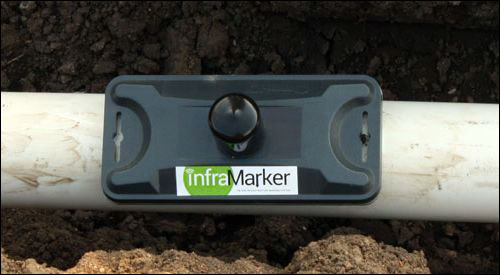Earlier this month, InfraMarker—a division of Berntsen International, a manufacturer and supplier of survey and utility markers and related equipment—released a new iteration of a solution that employs radio frequency identification to determine the exact locations of pipes and other tagged infrastructure buried beneath the ground. Previous versions depended solely on magnetic locators and RFID tags and readers, while the newest edition introduces the inclusion of GPS technology and real-time communication with the cloud. The new InfraMarker system will bring underground assets into the Internet of Things, says Bill Rushing, Berntsen International’s VP of R&D.
Construction accidents involving underground assets can cause deaths, financial losses and environmental damage. A water main struck by a backhoe can flood a city block, and even just nicking a natural gas line can cause a fatal explosion. With legacy location technology, pinpointing the whereabouts of an underground asset is a cumbersome and unreliable process that often requires calling an outside contractor with specialized equipment, which drives up a project’s cost. Even with many states offering free utility location hotlines, diggers sometimes do without.

Making It Easy for Diggers
The InfraMarker system—currently in use by college campuses, communities, utilities and private resorts in five states—aims to make it easier for municipalities, contractors and utilities to do this work themselves, safely and cost-effectively. Rushing cites a study from Auburn University‘s Geospatial Research & Applications Center (GRAC), which found that using GPS in conjunction with InfraMarker RFID tags and magnetic locators reduced location times for underground assets by 80 percent compared with using GPS alone.
The new InfraMarker system utilizes GPS, magnetic location and RFID technologies to locate and record information related to underground assets. GPS guides technicians to the approximate site, which they then confirm via video and pictures embedded in the asset’s record—all stored on the cloud, using a server hosted by Microsoft Azure cloud services. They then use a magnetic locator to pinpoint the asset’s precise location, as well as an RFID reader to verify its identity. All activity is uploaded to the cloud in real time.
The Equipment
The keystone of the InfraMarker system is the Juno T41 XRG handheld computer, from Trimble, which includes an RFID reader and antenna, a GPS unit, ThingMagic firmware and InfraMarker software. The system can operate in tandem with an Android-based smartphone—an innovation that reduces the weight and bulk of equipment required in the field. With the InfraMarker app available from the Google Play store, operators can use a smartphone to control the external RFID reader via a Bluetooth connection, enabling them to read and write InfraMarker tags in the field. The app enables cloud connectivity and integrates the phone’s camera to document an asset’s surroundings.
InfraMarker tags, manufactured by Omni-ID, contain a passive EPC Class 1 Gen 2 RFID inlay and, according to Rushing, “incorporate a magnet that will last forever. Users can employ the T41 XRG to edit data stored on the tag, or delete the tag record in the software. Three choices of tags allow a user to tailor the system to a project environment’s specific demands. Berntsen International offers packages for various applications.
Rushing trumpets the system’s ease of use in the field, stating, “Comparable systems require large field operations equipment, specialized training and cumbersome downloading to a customer’s management system. The InfraMarker system operates with a standard smartphone and less-than-shoebox-size RFID antenna, intuitive software for writing and reading tags, integrated video to ease locating, and cloud-based software to automatically link the field to the office in near-real time.” The external RFID reader weighs less than two pounds and can be carried in one hand.
A Trial Run
Since 2012, the city of Thiensville, Wisc., has been using an earlier iteration of the InfraMarker system to mark its force main sewer line (see RFID Helps Prevent Sewer Disasters). A force main requires something other than just gravity—pumps, for example—to move sewage. This means pressurizing the sewer, which could make the process more failure-prone. Locating it quickly thus becomes vital. The city’s experience with the InfraMarker system “provided good insight into how personnel in the field would use this type of system,” says Mike Klonsinski, Berntsen International’s director of business development. Klonsinski also believes that this deployment “verified the concept of magnetic detection to pinpoint location of the marker—and, therefore, the asset” and “helped lead us to develop InfraMarker as a more fully integrated infrastructure management system.”
Klonsinski describes a college campus deployment that “started with marking weld-points on high-pressure steam lines. The customer realized that these were the areas where leaks were most likely to occur… the InfraMarker marking has expanded to include other key asset points, such as elbow, tees and stubs.”
Rushing cites the Auburn University study as evidence of the system’s ease of use. Berntsen International offers onsite training as part of its startup packages, in tandem with online training videos. However, Klonsinski notes, the hardware and software were designed “to be as easy and intuitive as possible… we have minimized the need for operator workaround. This helps reduce the need for training.” Reliability is also a selling point, he adds. The tags are sealed to the IP68 standard, thereby providing protection against whatever environmental conditions they may encounter. “Even so,” Rushing admits, “a chip, like any electronic component, might be expected [to] fail,” though he posits that the system is fail-safed by the permanent magnet and GPS.
Locating underground assets is a high-stakes proposition. According to the company, the new release of the InfraMarker system aims to make it easier for municipalities, utilities and contractors to find them reliably. In so doing, it may reduce the incidence of expensive and tragic mishaps.

